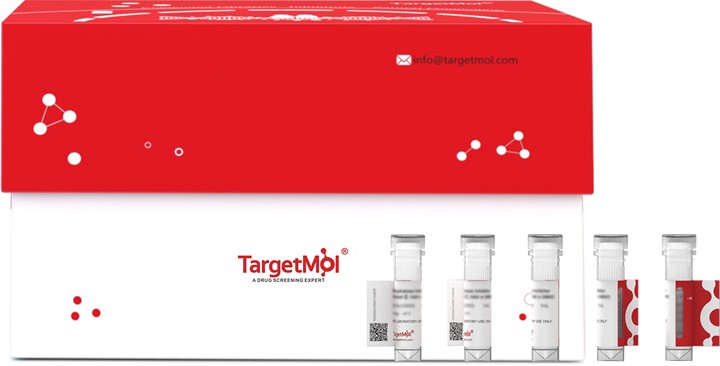 Your shopping cart is currently empty
Your shopping cart is currently empty
Notch 3 Protein, Human, Recombinant (His)
Catalog No. TMPK-01396
Human Notch-3 is part of the Notch family of type I transmembrane glycoproteins involved in a number of early-event developmental processes. The extracellular domain of Notch receptors interact with the extracellular domain of transmembrane ligands Jagged, Delta, and Serrate expressed on the surface of a neighboring cell. Upon ligand activation through the released notch intracellular domain (NICD) it forms a transcriptional activator complex with RBPJ/RBPSUH and activates genes of the enhancer of split locus. Affects the implementation of differentiation, proliferation and apoptotic programs.

Notch 3 Protein, Human, Recombinant (His)
Catalog No. TMPK-01396
Human Notch-3 is part of the Notch family of type I transmembrane glycoproteins involved in a number of early-event developmental processes. The extracellular domain of Notch receptors interact with the extracellular domain of transmembrane ligands Jagged, Delta, and Serrate expressed on the surface of a neighboring cell. Upon ligand activation through the released notch intracellular domain (NICD) it forms a transcriptional activator complex with RBPJ/RBPSUH and activates genes of the enhancer of split locus. Affects the implementation of differentiation, proliferation and apoptotic programs.
| Pack Size | Price | USA Warehouse | Global Warehouse | Quantity |
|---|---|---|---|---|
| 5 μg | $58 | 7-10 days | 7-10 days | |
| 10 μg | $92 | 7-10 days | 7-10 days | |
| 20 μg | $148 | 7-10 days | 7-10 days | |
| 50 μg | $289 | 7-10 days | 7-10 days | |
| 100 μg | $487 | 7-10 days | 7-10 days | |
| 200 μg | $883 | 7-10 days | 7-10 days | |
| 500 μg | $1,950 | 7-10 days | 7-10 days |
Add to Cart
Add to Quotation
In Stock Estimated shipping dateUSA Warehouse [1-2 days] Global Warehouse [5-7 days]
All TargetMol products are for research purposes only and cannot be used for human consumption. We do not provide products or services to individuals. Please comply with the intended use and do not use TargetMol products for any other purpose.
Resource Download
Product Information
| Biological Activity | Immobilized Human Notch 3, His Tag at 1μg/ml (100μl/Well) on the plate. Dose response curve for Anti-Notch 3 Antibody, hFc Tag with the EC50 of 14.2ng/ml determined by ELISA. |
| Description | Human Notch-3 is part of the Notch family of type I transmembrane glycoproteins involved in a number of early-event developmental processes. The extracellular domain of Notch receptors interact with the extracellular domain of transmembrane ligands Jagged, Delta, and Serrate expressed on the surface of a neighboring cell. Upon ligand activation through the released notch intracellular domain (NICD) it forms a transcriptional activator complex with RBPJ/RBPSUH and activates genes of the enhancer of split locus. Affects the implementation of differentiation, proliferation and apoptotic programs. |
| Species | Human |
| Expression System | HEK293 Cells |
| Tag | C-His |
| Accession Number | Q9UM47 |
| Synonyms | Notch-3,NOTCH3,Notch homolog 3,CADASIL |
| Construction | Ala1378-Ser1640 |
| Protein Purity | > 95% as determined by Tris-Bis PAGE; > 95% as determined by HPLC |
| Molecular Weight | 30.18 kDa (predicted). Due to furin-like protease cleavage and glycosylation, the protein migrates to 27-30 kDa and 10-12 kDa based on Tris-Bis PAGE result. |
| Endotoxin | < 1 EU/μg by the LAL method. |
| Formulation | Lyophilized from a solution filtered through a 0.22 μm filter, containing PBS (pH 7.4). Typically, 8% trehalose is incorporated as a protective agent before lyophilization. |
| Reconstitution | Reconstitute the lyophilized protein in distilled water. The product concentration should not be less than 100 μg/ml. Before opening, centrifuge the tube to collect powder at the bottom. After adding the reconstitution buffer, avoid vortexing or pipetting for mixing. |
| Stability & Storage | It is recommended to store recombinant proteins at -20°C to -80°C for future use. Lyophilized powders can be stably stored for over 12 months, while liquid products can be stored for 6-12 months at -80°C. For reconstituted protein solutions, the solution can be stored at -20°C to -80°C for at least 3 months. Please avoid multiple freeze-thaw cycles and store products in aliquots. |
| Shipping | In general, Lyophilized powders are shipping with blue ice. |
| Research Background | Human Notch-3 is part of the Notch family of type I transmembrane glycoproteins involved in a number of early-event developmental processes. The extracellular domain of Notch receptors interact with the extracellular domain of transmembrane ligands Jagged, Delta, and Serrate expressed on the surface of a neighboring cell. Upon ligand activation through the released notch intracellular domain (NICD) it forms a transcriptional activator complex with RBPJ/RBPSUH and activates genes of the enhancer of split locus. Affects the implementation of differentiation, proliferation and apoptotic programs. |
Dose Conversion
You can also refer to dose conversion for different animals. More
Calculator
Tech Support
Please read the User Guide of Recombinant Proteins for more specific information.
Generate Quote
Catalog No.: Cas No.:
Add
| Size | Quantity | Unit Price | Amount | Operation |
|---|
Generate Quote

Copyright © 2015-2025 TargetMol Chemicals Inc. All Rights Reserved.



